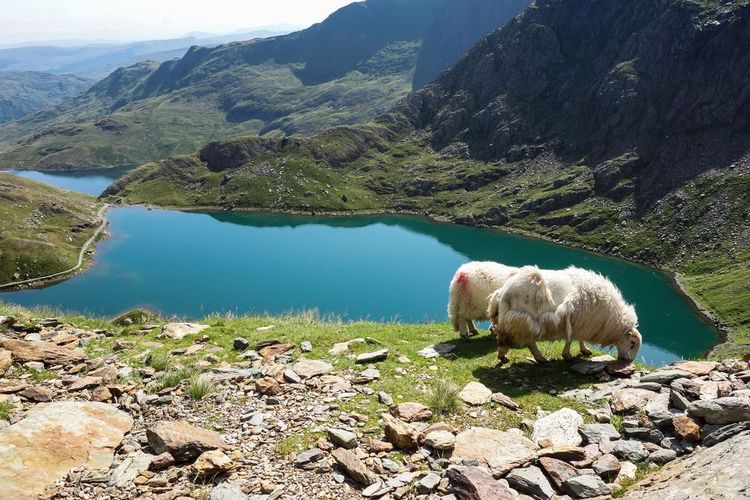 Wales
Wales
The capital of Wales both administratively and culturally, Cardiff has somehow remained a hidden gem among the UK’s swelling reliquary of must-see cities on the post-industrial rebound, lost somewhere between the sleek modernity of nearby Bristol, the Scouse soul of historic Liverpool, the charismatic grunge of underground Glasgow, and the bohemian chic of coastal Margate. Cardiff’s ‘forgottenness’ seems almost something of a microcosm for the state of Wales in general, the black sheep of the four united kingdoms that finds itself overshadow by the pure cultural (and economic) capital of elder-brother England, the wile and charm of up-north Scotland, and the mysterious emerald-tinged air that shrouds across-the-ocean Northern Ireland. However, as the tiny nation’s flagship city, Cardiff is also showcases microcosmically all that makes Wales such a singular, spectacular location, a city full of warmth and energy where ancient cobbles and castles meet whimsical and storied tradition meet savage wilds and expansive waters meet the modern day. In Cardiff, all these elements crystalise into one city, firmly anchored by its past but eagerly awaiting and grasping forwards a dynamic future. Cardiff may be small, its name rather uncommanding, however it stands pregnant with history, culture, and life in the heart of Wales, all of this converging to make a city that is perhaps Britain’s best-kept open secret.
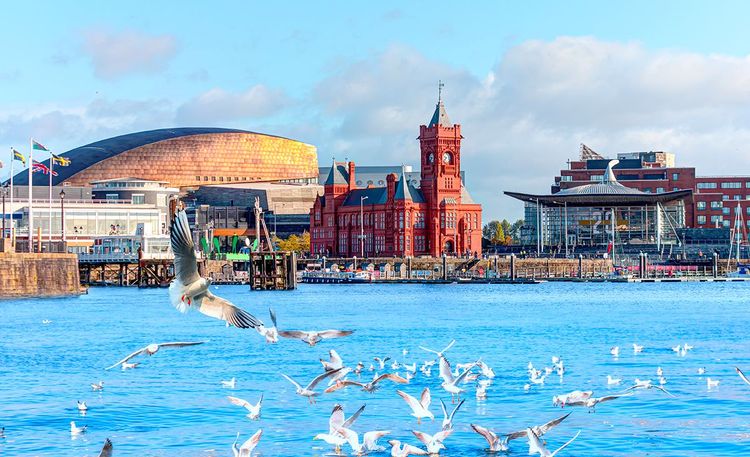
Cardiff Bay
- © muratart / ShutterstockWhere to Go
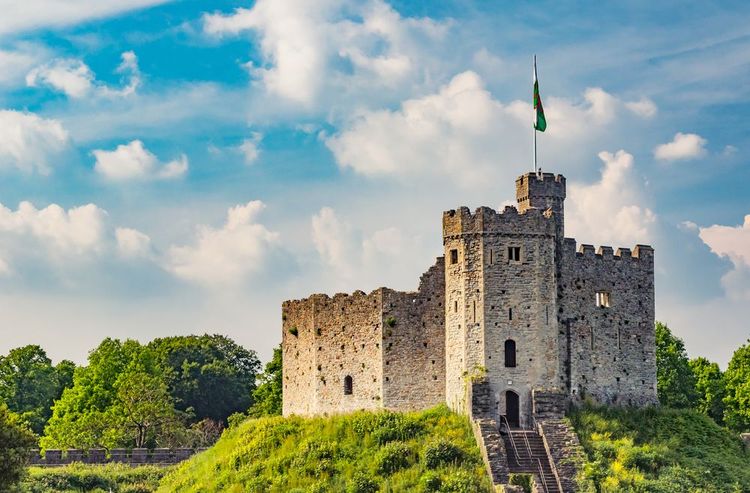
Cardiff Castle
- © CanonDLee / ShutterstockPerched rather incongruously in Cardiff’s commercial centre, rising from above the brand-name high street shops and glistening glass-and-steel government buildings, Cardiff Castle certainly has an effect of incongruity. Maybe some of that lies in its architectural mish-mash of a facade for which it had been accused of disingenuity, the Victorian-era renovations, most notably its magnificent clock tower, making it seem something of an ersatz castle, the folly of some nineteenth-century medievalist with too much money to burn. Although there may be some truth in this (slightly harsh) assumption, the fact still stands that the motte-and-bailey castle structure was originally built in the late 11th century by Norman invaders who themselves used the remains of a Roman fort that existed on the site as early as 55 AD. The misconception is due to the vast works enacted on the ancient castle by John Chrichton-Stuart, 3rd Marquess of Bute, and his architectural partner-in-crime William Burges in the late-nineteenth century. Bute inherited the castle from his late coal-monopolist father upon the latter’s death in 1848 and, along with it, a treasure trove of assets that reportedly made him the richest man in the world at the time. Bute had a disaffect for the industrial grime of Victorian Britain and yearned for the grandeur and simplicity of the nation’s mythic medieval past, a philosophy he shared with Burges, an illustrious English architect whose Gothic Revival wonders evoked his same utopic Britain of yesteryear. With Bute’s money and Burges’ expertise, Cardiff Castle was transformed into a fairytale playhouse, both inside and out.
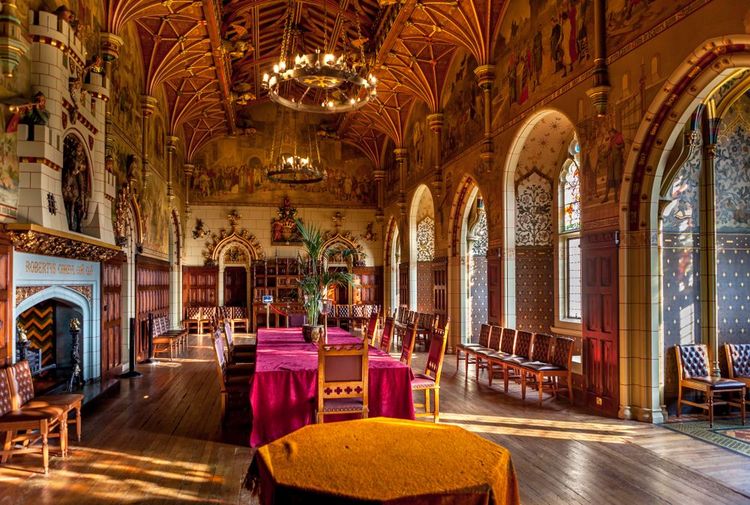
Interior of a section of Cardiff Castle, Cardiff, Wales.
- © Edward Haylan / ShutterstockThe castle’s interiors thus became an eccentric tapestry of influences and desires. As well as erecting the grand Clock Tower whose inside is decorated with artwork and decor telling the stories of Time, astrology, and alchemy (a reference to the mineral origins of his family’s wealth), Butes commissioned, to name just a few of the Castle’s internal: a nursery decorated with painted tiles depicting Aesop’s Fables and other children’s stories, the Islamic decadence of the Moorish Arab Room, and a colossal library flanked by whimsical carvings. The result is, in the words of historian Megan Aldrich, a decor that was “rarely equalled” in the culturescape of Victorian England and a labyrinth of rooms that feel like “three dimensional passports to fairy kingdoms and realms of gold”, according to J. Mourdant Crook, the “[entryway to] a land of dreams”.
Today, you too can enter into this land of dreams for a small admission fee, thereby gaining access into what is undoubtedly one of the Seven Wonders of the Victorian World. A ticket will also let you visit the castle’s subterranean Roman ruins, the military museum, the surrounding battlements for a history-steeped stroll, and the air-raid shelters that were installed in the castle walls during the Second World War. A gift shop and cafe are also available onsite, while access to the Castle’s gardens is completely free.
Practical Information
- The Castle is normally open 7 days a week including bank and school holidays, except 25 December, 26 December, and 1st January. From March to October, the Castle is open from 10am Monday to Friday and 9am Saturday and Sunday until 6pm. From November to February it closes earlier, at 5pm. Please note that last entry is always an hour prior to closing. Additionally, the Castle sometimes closes for events, so check the website before visiting.
- Cardiff Castle is located in the centre of the city and is therefore very well serviced by transport: there are several bus stops located around the Castle from all over the city, while park and ride buses run straight to the city centre and there are several car parks located near the site. For more information, visit the website here.
- A standard adult ticket costs £14.50. Concession tickets for students, seniors, and those with disabilities costs £12. Under 16’s get in for £10, and under £5s get in for free. Detailed guided tours of the site can also be booked for a small additional fee. All tickets can be booked online in advance, which is recommended as Cardiff Castle is one of the city’s most popular tourist attractions. For more information and to buy a ticket, go to the official website here.
- If you want a different experience of the Castle, concerts and other events are also held here from time to time. For more information, see the events schedule here.
- Cardiff Castle is an accessible attraction, although there may be some limitations due to the age of the building. For more information, consult the site here.
 Wales
Wales
National Museum Cardiff, a Hearth of Welsh National Heritage
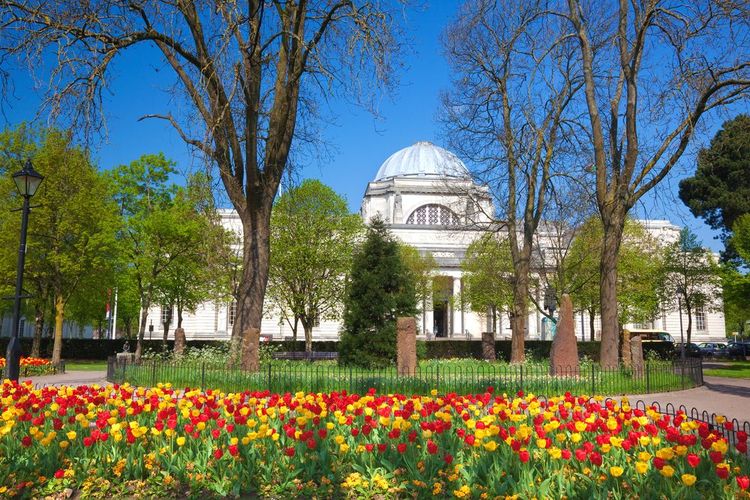
National Museum Cardiff, Cardiff.
- © Billy Stock / ShutterstockThe National Museum Cardiff is Wales’ biggest and most varied museum, featuring collections on Welsh natural history, geology, botany, prehistory, and national art, as well as an extensive collection of European art.
The first floor of the museum is dedicated to Wales’ national art collections that span 500 years of art history and every medium from painting to sculpture to drawing to ceramic. The spotlight is firmly placed on Welsh art, with notable names including the pioneering eighteenth-century landscape painter Richard Wilson and his convention-bending pupil Thomas Jones; neoclassical sculptor and favourite of Queen Victoria John Gibson; acclaimed twentieth-century surrealist printmaker Ceri Richards; enigmatic portraitist Gwen John; and Sir Kyffin Williams, often hailed as the most important Welsh artist of the last century. The collection also features one of the largest collections of Impressionist art in Europe. International masters whose works have found a home in the gallery halls include Rembrant, Poussin, Monet, Van Gogh, Renoir, Kokoschka, Francis Bacon, and Picasso.
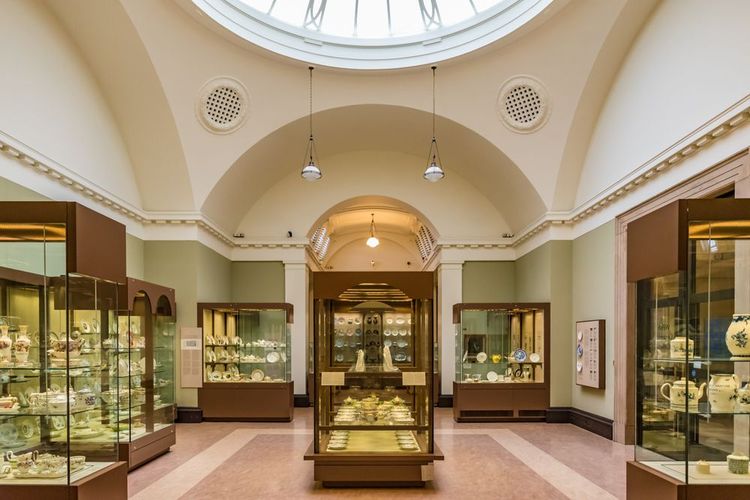
National Museum Cardiff, Cardiff.
- © Takashi Images / ShutterstockElsewhere in the museum is the natural history collections. The ‘Evolution of Wales’ permanent exhibition traces the 4,600 million-year story of Wales’ formation through meteorites, moon rock, fossils, and woolly-mammoth replicas to help contextualise how Wales’ arresting natural landscapes came to be. Meanwhile, the permanent Natural History collection allows guests to discover the richness and diversity of the Welsh wild, from the basking shark to the puffin to the humpback whale to the world’s largest leatherback turtle, who washed up on a North Welsh shores in 1988 and now has an entire display in the gallery dedicated to him. There is also a Diversity of Life gallery for a more global outlook. Here, visitors will encounter everything from pitcher plants to snow leopards to a 1.2m long giant earthworm! Tickets to the National Museum Cardiff are free, so a visit is not to be missed.
Practical Information
- The museum is open from 10am to 5pm every day from Tuesday to Sunday. Although it is closed on Mondays, it opens for Bank Holiday Mondays. The museum stays open until 9pm on the first Thursday of every month. For more information, check the museum website here.
- Entry to the museum is free, although donations are heavily encouraged and there are various donation points throughout the galleries.
- National Museum Cardiff is located at Cathays Park, which is about a 20 minute walk from central Cardiff. Bus number 35 runs to the Museum from Wyndham Arcade in central Cardiff. Cardiff Queen Street Train Station is also an 880 yard walk from the Museum; trains run to Cardiff Queen Street from Cardiff Bay Station. A Visitor Car Park is situated behind the Museum off Museum Avenue and costs £6.50, card only. For more travel information, visit the website here.
- Free audioguides are available and daily 35-minute tours are run from 12:30pm for no additional charge/
- National Museum Cardiff is an accessible space. For more information, visit the website here.
What to Do
Rugby at the Millennium Stadium, the Sport that Birthed a Nation

The Welsh National Team prepares to meet Italy at Cardiff's Millennium Stadium.
- © Paolo Bona / Shutterstock“There’s nowhere on Earth like Cardiff on international rugby day. Yes, there are things which come close. We get pretty excited when our national football team is in town, or a boxing world title is at stake. It’s thrilling when Beyoncé or the Rolling Stones are rocking the city. But for a unique global cultural experience, it has to be rugby, it has to be the [Millennium] Stadium, and it has to be Cardiff.”
- Charles Williams, Welsh writer and broadcaster.
Rugby is more than just Wales’ national sport, it is Wales’ national identity. Arriving in Wales through the English public schools system in the late-nineteenth century, the gruelling, physical sport soon became an obsession of the Welsh working class and spread through the nation with the onset of industrialisation, with games already beginning to attract crowds of 30,000 or 40,000 by the 1890s. A Triple Crown victory against England, Scotland, and Ireland in 1893 gave way to the first ‘Golden Age’ of Welsh rugby at the start of the new century, when Wales won six Triple Crowns in just eleven years before beating New Zealand’s legendary All Blacks in 1905, making the sport an indelible part of the country’s national tapestry and giving tiny Wales a fleeting chance to be King of the United Kingdom and even King of the World.
The Millennium Stadium is the behemothic shrine to this national obsession, built to host the 1999 Rugby World Cup from 56,000 tonnes of concrete and steel. Capable of holding almost 74,000 fans at maximum game-day capacity, it is considered one of the best rugby stadiums in the world in terms of both atmosphere and design and keeps a carnival feel throughout match day. Typically, only four or five international rugby games are played at the Millennium Stadium every year, normally during the Six Nations, the biggest annual rugby competition in the world. However, even for those who are unfamiliar with the sport, attending an international rugby match at the Millennium Stadium is a once-in-a-lifetime experience during which one will see a country at its proudest and celebrations that rivals some of the biggest parties in the world. If you want to see Wales then sure, you can visit its castles or wilderness or museums, but if you want to experience Wales, then you need to go to the rugby.
Practical Information
- Due to sponsorship arrangements, the Millennium Stadium currently operates under the name ‘Principality Stadium’.
- Six Nations tickets are mostly distributed through local rugby clubs, so, unless you play rugby (or know somebody who plays rugby) in Wales, your best bet is to buy one of the thousands of tickets that inevitably ends up on the secondary and hospitality markets. Prices are likely to be inflated, but the experience is truly unmissable.
- If you’re unable to make it to an international game, countless other events are run throughout the year, as well as stadium tours. For more information, visit the website here.
- The Millennium Stadium is unmissably located in the heart of the city and dominates the skyline, making it easily findable on foot anywhere in and around the city centre. On match days it is recommended to walk to the stadium if possible, as public transport gets quickly congested. The nearest train station is Cardiff Central, while Cardiff Queen Street Station is a fifteen-minute walk away. There are no dedicated car parks. For more information, visit the website here.
- The Millennium Stadium is considered an accessible venue. For more information, visit the website here.
Our favourite hotel near the Millennium Stadium
 Wales
Wales
Parador 44
A lovely hotel located in the centre of Cardiff.Editor's Tip
Even if you can’t get a ticket to the game itself, it’s well worth coming to Cardiff on game day just to soak in the unrivalled atmosphere. Swarms of ticketless fans still flock to Cardiff to watch Wales play live on giant screens in pubs, bars, and outdoor public spaces throughout the city to a lively, friendly, and beer-flavoured ambience. Some perennial favourites are O’Neill’s, Walkabout, and Brewhouse on St. Mary Street, Cardiff’s main high street that runs parallel to the Stadium, or Tiger Tiger, Yates, and Live Lounge on nearby Greyfriars Road.
Explore Cardiff Bay, Where City Meets Sea

The Wales Millenium Centre in Cardiff Bay at sunset.
- © Billy Stock / ShutterstockRunning from Cardiff city centre to neighbouring Penarth, a small seaside resort town known as Britain’s “Garden by the Sea”, Cardiff Bay is the largest waterfront development in Europe and both one of the most successful and one of the most radical urban regeneration projects that the UK has ever seen. Once a derelict wasteland of abandoned docks and mudflats after the post-war collapse of the British coal industry, it was reborn in the early 2000s when the Cardiff Bay Barrage turned the bay into a gigantic non-tidal, high-water lake decorated with dazzling modern developments such as the Senedd Building (the seat of the Welsh government) and the Wales Millennium Centre, both of which have received critical praise and numerous architectural awards. The integration of these contemporary architectural masterpieces into the historic docklands has created a mosaic of past and present along the shoreline and a testament to the diversity of Cardiff as a whole. A prime example of this is the Norwegian Church, a rebuilt Lutheran church originally erected in 1868 as a place of worship for the large numbers of Scandinavian sailors who passed through the city’s port. Today, it serves as an art centre that celebrates the life and work of legendary Welsh children’s writer Roald Dahl, who was born in Cardiff to Norwegian parents and was baptised in the church as a child. The iconic Pierhead Building can also be found along the Bay, one of Cardiff’s handful of Grade I-listed buildings.
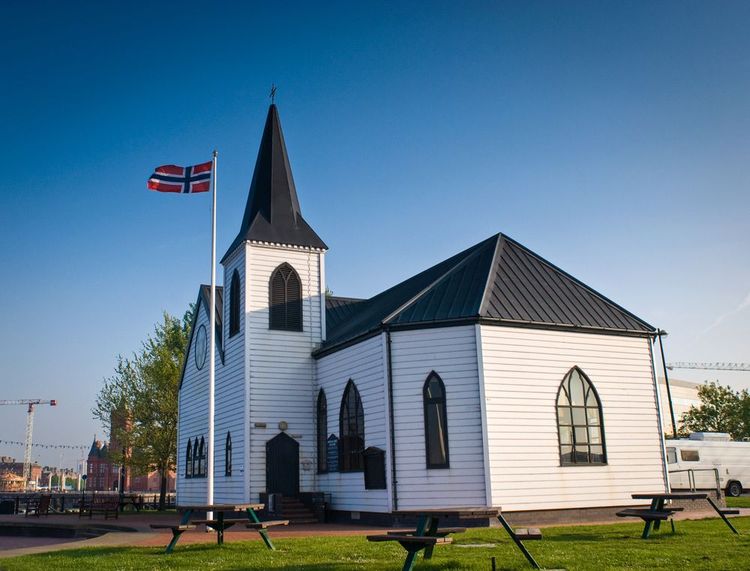
The Norwegian Church in Cardiff, Wales.
- © Matthew Dixon / ShutterstockNow, Cardiff Bay is colossal, and touring it in its entirety is an ambitious yet well worth-it task. For those willing to take on the challenge, there’s a 10km (6.2mile) circular trail encompassing the bay via a 140-metre overwater bridge that connects Penarth to Cardiff’s International Sports Village. You can choose to tackle the route in sections over the course of your visit to take the time to amble through all the weird and wonderful attractions that litter the path, from the ‘Beastie Benches’ inspired by the mythical monsters from Dylan Thomas’ poem The Ballad of the Long-Legged Bait to the eight-hectare Wetlands Reserve located at the mouth of the River Taff. Or, you can squeeze the entire bay into a single day by renting a bike and taking on the epic circular for a bit of exercise and crisp coastal air. There’s truly no better way to see the city!
Practical Information
- Cardiff Bay is easily reached from the city centre: trains from Cardiff Central Station to Cardiff Bay run every day ten minutes via Cardiff Queen Street and cost around £3, while bus lines 6 (nicknamed “Baycar”), 7, and 9 all service Cardiff Bay from Cardiff city centre. There are also various parking options around Cardiff Bay. For more information, visit the Cardiff Bay website here.
Where to Eat
Cardiff Market
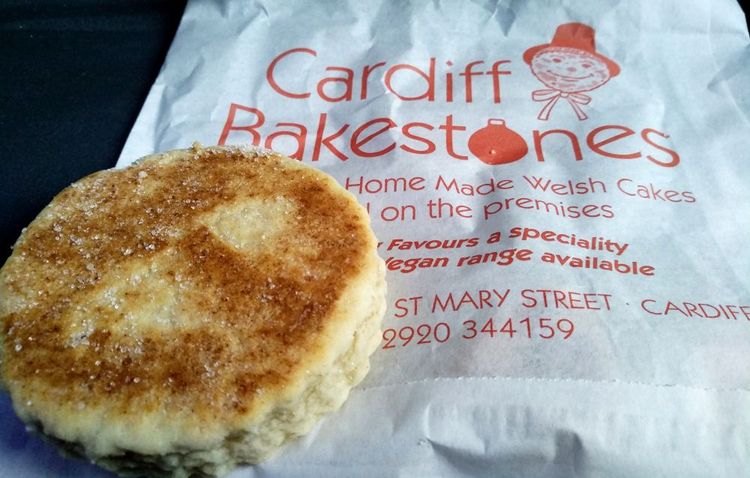
A traditional Welsh Cake from Cardiff Bakestones, located in Cardiff Market, Cardiff.
- © Ariya J / ShutterstockOnce the site of the Cardiff gaol, the Cardiff Market, which has existed in some form since the 1700s, was erected in the 1890s in a classically Victorian style, glass roof and all. Today, the market offers a myriad of stalls across its two floors. Here you will find a variety of fresh local goods and Welsh delicacies, as well as artisan coffee, contemporary street food, second-hand clothes and records, and even a psychic medium!
The market offers cuisine ranging from Mediterranean to Indian to Thai, however it is most notably home to Cardiff Bakestones, the place to go in the city if you want to try authentic homemade Welsh Cakes. Named ‘Bakestones’ as the Welsh Cakes here are still cooked on a traditional Welsh bakestone, guests can watch their cakes being made right before their eyes. A range of flavours, from plain to coconut to Nutella to lemon curd, are offered, while gluten-free and vegan options are also available upon request.
Practical Information
- Cardiff Market is open every day of the week from 8am to 5pm except on Sundays, when it is closed.
- Cardiff Market is located on St. Mary’s Street in the heart of Cardiff. Cardiff Central train and bus stations are just a short walk away, while there is plenty of parking available in the vicinity. Consult the Cardiff Council website for further information.
Mermaid Quay
Mermaid Quay, Cardiff Bay’s chic, cosmopolitan heart, is home to over thirty restaurants, cafes, and bars, all with a breathtaking waterfront location for the ideal dining experience capable of catering to all tastes. Alongside can’t-go-wrong, chain favourites like Wagamamas, Las Iguanas, and Cote Brasserie, Mermaid Quay offers a range of independent eateries that have become staples of the Cardiff culinary scene. Demiro’s has been serving the quay delicious Italian food for over fifteen years and maintains a perennially lively atmosphere with its singing waiters. Signor Valentino, meanwhile, is unique for its al fresco dining terrace from which guests can enjoy oven-baked pizzas and a delightful range of cocktails. Come to Mermaid Bay and take your pick, you’re sure not to be disappointed!
Practical Information
- Mermaid Quay has a 380-space, two-level visitor car park. It is serviced from Cardiff city centre by the number 6 and 8 buses and the aquabus. For more information, visit the website.
How to go
By Car
Cardiff can easily be reached via the M4 motorway, which runs through the north of the city. London is only three miles away by car, while those coming from the Midlands, the North of England and Scotland will enjoy a straightforward drive via the M6, M5 and M50/M4. From the South and South West of England, use the M5 and M4. Access from West Wales is via the M4.
By Train
Cardiff is serviced by three main train stations: Cardiff Central, Cardiff Queen Street, and Cardiff Bay. The city is less than two hours from London by train, with services every 30 minutes. Cardiff also has direct services to Bristol, Bath, Birmingham, Manchester, Nottingham and other major cities. Consult the Trainlines website to plan a rail journey.
By Air
Cardiff Airport offers direct flights to and from cities such as Edinburgh, Belfast, Dublin, Paris, and Amsterdam. The airport is located in the Vale of Glamorgan, 13 miles west of Cardiff. Those flying into Cardiff can easily travel to and from the airport by public transport which runs regularly, reliably, and frequently.
Editor's Tip
Although English is spoken universally in Cardiff, Welsh people are fiercely proud of their heritage and language and you will often hear Welsh being spoken in the city, as well as seeing it written on street signs and elsewhere. If you want to try out a bit of Welsh while visiting, a gesture than many a Welshperson is sure to appreciate, here are some basic phrases you can easily use:- Os Gwelwch Yn Dda - Please
- Diolch – Thank You
- Iechyd Da – Cheers
- Hwyl Fawr – Goodbye
- Bore Da – Good Morning
- Prynhawn Da – Good Afternoon
- Nos Da – Good NightIf you need help practising pronunciations, there are plenty of helpful guides on YouTube and other video sharing platforms!
